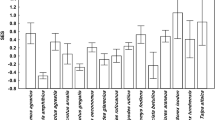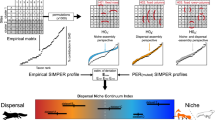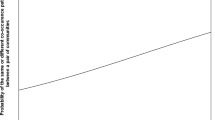Abstract
The number of species coexisting in a community may be regulated by local factors (e.g., competitive interactions), or by regional processes (e.g., dispersal from a regional species pool). The relative importance of local and regional processes can be inferred from the shape of the relationship between local and regional species richness. We investigated this relationship in communities of fleas parasitic on small mammals at two spatial scales: between the richness of fleas on individual hosts (infracommunities) and that of fleas on host populations (component communities), and between the richness of component communities and that of the entire regional species pool. We tested linearity (proportional sampling) versus curvilinearity with an asymptote (species saturation) by plotting “local” against “regional” species richness of fleas either among host species or within host species among populations. At the two spatial scales, we found consistent curvilinear relationships between species richness of the more “local” communities and richness of the more “regional” communities. This was true across all host species in the data set and for geographic subsets, even after controlling for the influence of sampling effort on estimates of species richness, and that of host phylogeny in interspecific analyses. We also tested for density compensation in species-poor communities. There was no strong evidence for density compensation at the infracommunity level, although its existence at the component community level appeared likely. Our results suggest that identical patterns in local-versus-regional species richness observed on two different spatial scales arise via different mechanisms: infracommunities appear saturated with flea species most likely because of local processes, such as host immune defenses, whereas component communities are saturated with species through interspecific competition, possibly among larval stages.




Similar content being viewed by others
References
Bell G (2003) The interpretation of biological surveys. Proc R Soc Lond B 270:2531–2542
Braks MAH, Honorio NA, Lounibos LP, Lourenco de Oliveira R, Juliano SA (2004) Interspecific competition between two invasive species of container mosquitoes, Aedes aegypti and Aedes albopictus (Diptera: Culicidae), in Brazil. Ann Entomol Soc Am 97:130–139
Caley MJ, Schluter D (1997) The relationship between local and regional diversity. Ecology 78:70–80
Calvete C, Blanco-Aguiar JG, Virgos E, Cabezas-Diaz S, Villafuerte R (2004) Spatial variation in helminth community structure in the red-legged partridge (Alectoris rufa L.): effects of definitive host density. Parasitology 129:101–113
Cornell HV (1993) Unsaturated patterns in species assemblages: the role of regional processes in setting local species richness. In: Ricklefs RF, Schluter D (eds) Species diversity in ecological communities: historical and geographical perspectives. Univ. of Chicago Press, Chicago, pp 243–252
Cornell HV, Lawton JH (1992) Species interactions, local and regional processes, and limits to richness of ecological communities: a theoretical perspective. J Anim Ecol 61:1–12
Cresswell JE, Vidal-Martinez VM, Crichton NJ (1995) The investigation of saturation in the species richness of communities: some comments on methodology. Oikos 72:301–304
Day JF, Benton AH (1980) Population dynamics and coevolution of adult siphonapteran parasites of the southern flying squirrel (Glaucomys volans volans). Am Midl Nat 103:333–338
Fox JW, McGrady-Steed J, Petchey OL (2000) Testing for local species saturation with nonindependent regional species pools. Ecol Lett 3:198–206
Garland T Jr, Harvey PH, Ives AR (1992) Procedures for the analysis of comparative data using phylogenetically independent contrasts. Am Nat 41:18–32
Gaston KJ, Blackburn TM (2000) Pattern and process in macroecology. Blackwell, Oxford
Griffiths D (1997) Local and regional species richness in North American lacustrine fish. J Anim Ecol 66:49–56
Griffiths D (1999) On investigation local–regional species richness relationships. J Anim Ecol 68:1051–1055
Guégan J-F, Morand S, Poulin R (2005) Are there general laws in parasite community ecology? The emergence of spatial parasitology and epidemiology. In: Thomas F, Guégan J-F, Renaud F (eds) Parasitism and ecosystems. Oxford Univ. Press, Oxford, pp 22–42
Hawkins BA, Compton SG (1992) African fig wasp communities: undersaturation and latitudinal gradients in species richness. J Anim Ecol 61:361–372
Heino J, Muotka T, Paavola R (2003) Determinants of macroinvertebrate diversity in headwater streams: regional and local influences. J Anim Ecol 72:425–434
Hillebrand H (2005) Regressions of local on regional diversity do not reflect the importance of local interactions or saturation of local diversity. Oikos 110:195–198
Hillebrand H, Blenckner T (2002) Regional and local impact on species diversity-from pattern to processes. Oecologia 132:479–491
Hsu M-H, Hsu T-C, Wu W-J (2002) Distribution of cat fleas (Siphonaptera: Pulicidae) on the cat. J Med Entomol 39:685–688
Hugueny B, Paugy D (1995) Unsaturated fish communities in African rivers. Am Nat 146:162–169
Felsenstein J (1985) Phylogenies and the comparative method. Am Nat 125:1–15
Karlson RH, Cornell HV, Hughes TP (2004) Coral communities are regionally enriched along an oceanic biodiversity gradient. Nature 429: 867–870
Kennedy CR, Guégan J-F (1996) The number of niches in intestinal helminth communities of Anguilla anguilla: are there enough spaces for parasites? Parasitology 113:293–302
Khokhlova IS, Spinu M, Krasnov BR, Degen AA (2004a) Immune responses to fleas in two rodent species differing in natural prevalence of infestation and diversity of flea assemblages. Parasitol Res 94:304–311
Khokhlova IS, Spinu M, Krasnov BR, Degen AA (2004b) Immune response to fleas in a wild desert rodent: Effect of parasite species, parasite burden, sex of host and host parasitological experience. J Exp Biol 207:2725–2733
Krasnov BR, Shenbrot GI, Medvedev SG, Vatschenok VS, Khokhlova IS (1997) Host–habitat relation as an important determinant of spatial distribution of flea assemblages (Siphonaptera) on rodents in the Negev Desert. Parasitology 114:159–173
Krasnov BR, Khokhlova IS, Fielden LJ, Burdelova NV (2001) The effect of temperature and humidity on the survival of pre-imaginal stages of two flea species (Siphonaptera: Pulicidae). J Med Entomol 38:629–637
Krasnov BR, Khokhlova IS, Fielden LJ, Burdelova NV (2002) Time to survival under starvation in two flea species (Siphonaptera: Pulicidae) at different air temperatures and relative humidities. J Vector Ecol 27:70–81
Krasnov BR, Shenbrot GI, Khokhlova IS, Degen AA (2004a) Flea species richness and parameters of host body, host geography and host “milieu”. J Anim Ecol 73:1121–1128
Krasnov BR, Shenbrot GI, Khokhlova IS, Degen AA (2004b) Relationship between host diversity and parasite diversity: flea assemblages on small mammals. J Biogeogr 31:1857–1866
Krasnov BR, Burdelova NV, Khokhlova IS, Shenbrot GI, Degen AA (2005) Pre-imaginal interspecific competition in two flea species parasitic on the same rodent host. Ecol Entomol 30:146–155
Lawrence W, Foil LD (2002) The effect of diet upon pupal development and cocoon formation by the cat flea (Siphonaptera: Pulicidae). J Vector Ecol 27:39–43
Lawton JH, Lewinsohn TM, Compton SG (1993) Patterns of diversity for the insect herbivores on bracken. In: Ricklefs RF, Schluter D (eds) Species diversity in ecological communities: historical and geographical perspectives. Univ. Chicago Press, Chicago, pp 178–184
Loreau M (2000) Are communities saturated? On the relationship of ά, β and δ diversity. Ecol Lett 3:73–76
Maddison WP, Maddison DR (2004) Mesquite: a modular system for evolutionary analysis. Version 1.05. http://mesquiteproject.org
Marshall AG (1981) The ecology of ectoparasite insects. Academic, London
McArthur RH, Diamond JM, Karr JR (1972) Density compensation in island faunas. Ecology 53:330–342
Midford PE, Garland T Jr, Maddison WP (2005) PDAP: PDTREE package for Mesquite, Version 1.06 http://mesquiteproject.org/pdap_mesquite/index.html
Morand S, Poulin R (1998) Density, body mass and parasite species richness of terrestrial mammals. Evol Ecol 12:717–727
Morand S, Poulin R, Rohde K, Hayward C (1999) Aggregation and species coexistence of ectoparasites of marine fishes. Int J Parasitol 29:663–672
Oberdorff T, Hugueny B, Compin A, Belkessam D. (1998) Non-interactive fish communities in the coastal streams of North western France. J Anim Ecol 67:472–484
Poulin R (1996) Richness, nestedness, and randomness in parasite infracommunity structure. Oecologia 105:545–551
Poulin R (1998) Evolutionary ecology of parasites. from individuals to communities. Chapman & Hall, London
Rohde K (1998) Is there a fixed number of niches for endoparasites of fish? Int J Parasitol 28:1861–1865
Shurin JB, Allen EG (2001) Effects of competition, predation, and dispersal on species richness at local and regional scales. Am Nat 158:624–637
Shurin JB, Havel JE, Leibold MA, Pinel-Alloul B (2000) Local and regional zooplankton species richness: a scale-independent test for saturation. Ecology 81:3062–3073
Srivastava D (1999) Using local–regional richness plots to test for species saturation: pitfalls and potentials. J Anim Ecol 68:1–16
Stanko M, Miklisova D, Gouy de Bellocq J, Morand S (2002) Mammal density and patterns of ectoparasite species richness and abundance. Oecologia 131:289–295
Terborgh JW, Faaborg J (1980) Saturation of bird communities in the West Indies. Am Nat 116:178–195
Tonn WM (1985) Density compensation in Umbra-Perca fish assemblages of Northern Wisconsin lakes. Ecology 66:415–429
Valone TJ, Hoffman CD (2002) Effects of regional pool size on local diversity in small-scale annual plant communities. Ecol Lett 5:477–480
Acknowledgements
This study was partly supported by the Israel Science Foundation (Grant no. 249/04 to Boris Krasnov, Irina Khokhlova and Georgy Shenbrot) and by the Slovak Grant Committee VEGA (grant no. 2/5032/25 to Michal Stanko). This is publication no. 193 of the Ramon Science Center and no. 499 of the Mitrani Department of Desert Ecology.
Author information
Authors and Affiliations
Corresponding author
Electronic supplementary materials
Rights and permissions
About this article
Cite this article
Krasnov, B.R., Stanko, M., Khokhlova, I.S. et al. Relationships between local and regional species richness in flea communities of small mammalian hosts: saturation and spatial scale. Parasitol Res 98, 403–413 (2006). https://doi.org/10.1007/s00436-005-0049-z
Received:
Accepted:
Published:
Issue Date:
DOI: https://doi.org/10.1007/s00436-005-0049-z




